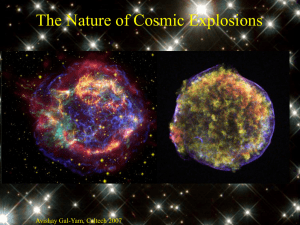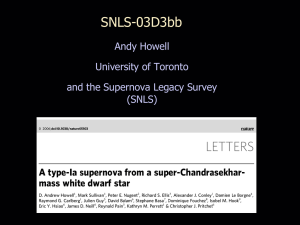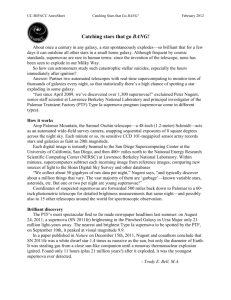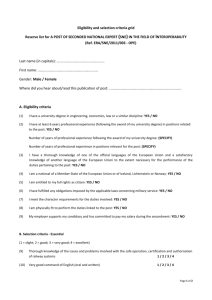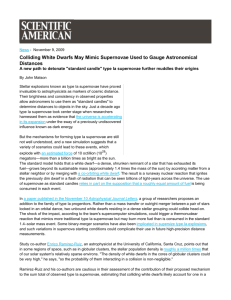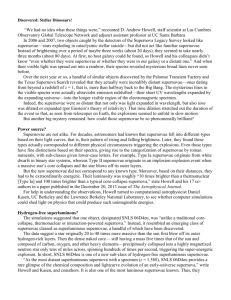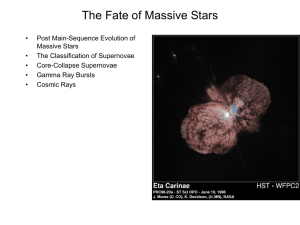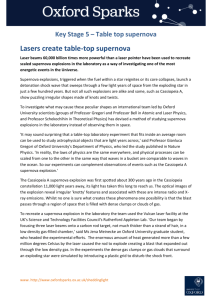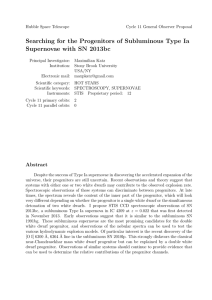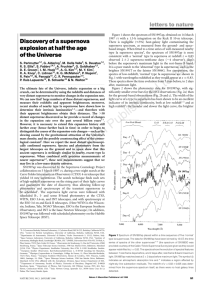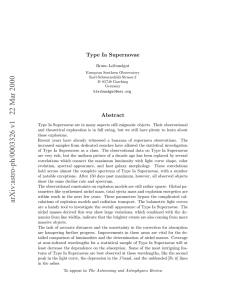Abstracts of talks
advertisement
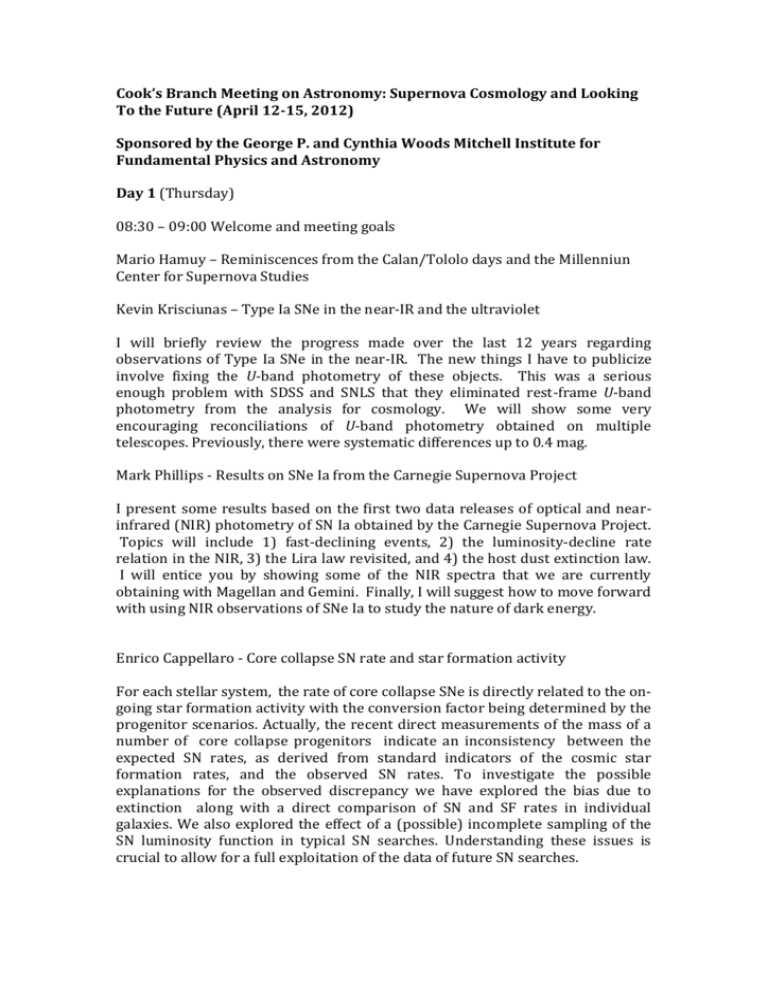
Cook’s Branch Meeting on Astronomy: Supernova Cosmology and Looking To the Future (April 12-15, 2012) Sponsored by the George P. and Cynthia Woods Mitchell Institute for Fundamental Physics and Astronomy Day 1 (Thursday) 08:30 – 09:00 Welcome and meeting goals Mario Hamuy – Reminiscences from the Calan/Tololo days and the Millenniun Center for Supernova Studies Kevin Krisciunas – Type Ia SNe in the near-IR and the ultraviolet I will briefly review the progress made over the last 12 years regarding observations of Type Ia SNe in the near-IR. The new things I have to publicize involve fixing the U-band photometry of these objects. This was a serious enough problem with SDSS and SNLS that they eliminated rest-frame U-band photometry from the analysis for cosmology. We will show some very encouraging reconciliations of U-band photometry obtained on multiple telescopes. Previously, there were systematic differences up to 0.4 mag. Mark Phillips - Results on SNe Ia from the Carnegie Supernova Project I present some results based on the first two data releases of optical and nearinfrared (NIR) photometry of SN Ia obtained by the Carnegie Supernova Project. Topics will include 1) fast-declining events, 2) the luminosity-decline rate relation in the NIR, 3) the Lira law revisited, and 4) the host dust extinction law. I will entice you by showing some of the NIR spectra that we are currently obtaining with Magellan and Gemini. Finally, I will suggest how to move forward with using NIR observations of SNe Ia to study the nature of dark energy. Enrico Cappellaro - Core collapse SN rate and star formation activity For each stellar system, the rate of core collapse SNe is directly related to the ongoing star formation activity with the conversion factor being determined by the progenitor scenarios. Actually, the recent direct measurements of the mass of a number of core collapse progenitors indicate an inconsistency between the expected SN rates, as derived from standard indicators of the cosmic star formation rates, and the observed SN rates. To investigate the possible explanations for the observed discrepancy we have explored the bias due to extinction along with a direct comparison of SN and SF rates in individual galaxies. We also explored the effect of a (possible) incomplete sampling of the SN luminosity function in typical SN searches. Understanding these issues is crucial to allow for a full exploitation of the data of future SN searches. Massimo Della Valle - SNe-Ia rates vs. environment I'll present SN-Ia rates vs. Radio luminosity of the host galaxies and rates in Seyfert/Liners galaxies. All data are extracted from Weidong's (LOSS) database. Josh Frieman - The Dark Energy Survey The Dark Energy Survey will employ a new, 570-megapixel digital imager on the Blanco 4-meter telescope at CTIO to carry out 2 surveys over 525 nights: a widearea survey of 5000 sq. deg. that will provide measurements of 200 million galaxies and a time-domain survey over 30 sq. deg. that will yield well-measured light curves for ~4000 type Ia supernovae. The aim of the project is to probe dark energy using 4 techniques: supernovae, clusters, galaxy clustering, and weak lensing. Installation on the telescope is now underway. I will overview the project, highlighting the goals of the supernova component. A primary theme will be the evolution of supernova cosmology into the era of massive surveys in which the number of SNe discovered will far outstrip the ability to carry out spectroscopic follow-up. In that context, I will highlight recent studies using photometric samples from the SDSS-II Supernova Survey. Lifan Wang – Observations from Antarctica Day 2 (Friday) Alexei Khokhlov - Towards exascale hydrodynamical simulations of Type Ia supernovae Radiation transport in SNIa requires a knowledge of detailed 3D density structure and detailed chemical composition of the ejecta from hydrodynamical modelling of various explosion models with detailed nuclear kinetic networks. This is becoming possible on emerging multi-petascale and exascale computers. I describe challenges and progress towards this goal and present first results of 3D modeling with detailed kinetics of incomplete carbon-oxygen detonation in outer layers of SNIa. Eddie Baron – A model for SN 2001ay I describe the work of our group to model the normal bright, extremely slow declining SN Ia, 2001ay. In order to fit the constraints of the light curve and spectra (slow decline and high velocities) an unusual model with a very high central C/O ratio was exploded in the pulsational delayed detonation framework. The resulting lightcurves and NLTE spectra were compared to observations and the agreement, while not perfect is quite good. We suggest that SN 2001ay is the prototype of a new class of SN Ia. Peter Hoeflich - Properties of the Progenitors of SNeIa from Light Curves and Spectra Light curves and spectra provide unique tool to study the progenitors and the conditions at the thermonuclear runaway. A physical understanding of thermonuclear explosions is needed to develop supernovae as a high precision tool in Cosmology and to control systematic variations with redshift and observational requirements. Evolutionary effects include changes in the progenitor population, metallicities and magnetic fields. Observational uncertainties include that the same supernovae may 'appear' different due to 3D effects. We will discuss the stability of light curve and spectral signatures in light of the ongoing discussion of the single and double degenerate systems. Type Ia Supernova allow to probe the nature of the 'dark energy' and, potentially, its directional dependence and the distribution of the dark matter. Craig Wheeler – the progenitor evolution of Type Ia supernovae The constraints on the evolution of binary star progenitor systems that give rise to SN Ia have gotten ever tighter with the observations of SN 2011fe and especially the limits on the left-over system due to deep HST images of SN Ia remnants in the LMC by Schaefer & Pagnotta. Both single-degenerate (SD) and double-degenerate (DD) models predict far more supersoft X-ray sources (SSS) than observed. Delayed detonation explosion models generally give better agreement with spectral evolution than do DD merger models. This seems to point at SD systems, but the lack of evidence for a left-over binary companion and apparent paucity of candidate systems weigh against this interpretation. Three new approaches to this problem are presented: 1) the circumstellar matter implied by the high-velocity calcium features in the early spectra of SN Ia would screen soft X-rays and strongly mitigate the issue of the paucity of SSS; 2) mixing induced by rotation of tidally-locked companions could yield hydrogenpoor matter that could mitigate the tendency for moderate mass transfer to yield nova explosions that prevent growth of the white dwarf to the Chandrasekhar mass; 3) the Schaefer/Pagnotta limit rules out all non-degenerate companions except M stars, but M stars are expected to be the most common white dwarf companions. M stars can be magnetically locked to the white dwarf, yielding white dwarfs rotating at the slow orbital speed. M dwarfs will transfer mass through flares rather than Roche lobe overflow. The accreted matter will flow along interlocking field lines between the two stars and channeled to magnetic poles on the white dwarf, concentrating the flow and giving effectively high mass transfer rates in localized areas that will serve to mitigate the nova eruption problem. M dwarfs will tend to be in close orbit such that their shed matter could comprise that detected in the high-velocity features. Peter Brown - Ultraviolet Observations of Type Ia Supernovae: The Problems and the Potential At first glance, the ultraviolet wavelengths would appear to be a poor spectral region to study standard candles for the measurement of cosmological distances. The strong absorption from metal lines result in a low flux that might change with redshift. The UV is more strongly affected by extinction than the optical with differences from grain sizes and circumstellar scattering more pronounced in the UV. Other sources for photometric variation in SNe Ia such as temperature, density, asymmetry, and velocity are also amplified in the UV. While these characteristics make standardization hard in the UV, it also makes the UV a unique wavelength band to study the differences in SNe Ia which are good but not perfect standard candles. The effect of UV on metalicity might allow one to trace differences in SNe over cosmic time that might be imperceptible in the optical. The origin and wavelength dependence of extinction can be traced using the long lever arm of the UV. Intrinsic differences between SNe can be studied via their effect on the UV. There is great potential to study the many potential sources of variation of SNe Ia via their effect on the UV-the problem is that there are many potential sources of variation affecting the UV. Disentangling these effects is the difficulty given our current--relatively small--data set. The contribution of UV observations from the International Ultraviolet Explorer, Hubble Space Telescope, and ground based observatories will also be discussed. The bulk of the talk will focus on the ongoing UV observations with the Swift/UltraViolet-Optical Telescope. Some possible directions for the near future will be discussed to prompt discussion and feedback. Lucas Macri - SH0ES: absolute calibration of the luminosity of type Ia SNe and cosmological implications I will review the results of the SH0ES program (PI: A. Riess), which has recently obtained an absolute calibration of the luminosity of type Ia SNe via Cepheid variables and determined the value of H0 with a total uncertainty of 3%. This provides important additional constraints on several cosmological parameters, such as the equation of state of dark energy and the number of neutrino species. I will also discuss future steps that may enable a determination of H0 to 1%. Day 3 (Saturday) Reynald Pain Ariel Goobar - Exploring systematics in SNIa: reddening and evolution I plan to discuss ongoing efforts to break the degeneracy between some of the potential sources of reddening in SNIa: interstellar dust, circumstellar dust and intrinsic color variations. Furthermore, I will present ideas on how to exploit gravitational lensing of supernovae by galaxy clusters to do high S/N spectroscopic studies of z~1.5 in the near-IR. John Tonry – A Wide but Shallow Survey I am trying to raise funds and interest for a "wide but shallow" sky survey capability, the idea being to be able to capture 4 steradians of sky to m=20 every night, or equivalent tradeoff between coverage and depth. A lot of transient and supernova science becomes easy, such as capturing a nightly light curve of every SNIa within z<0.1 that does not lie in the 1 steradian towards the Sun. The project and many science opportunites are described in PASP, 123, 58 (2011). An important goal is to make the system replicable for modest cost, and to distribute units over the globe. Chris Stubbs - Photometric Calibration Issues and SN Cosmology Photometric calibration uncertainty is the dominant source of systematic error for the current generation of Type Ia SN cosmology projects. I'll briefly review the current situation, and will describe some efforts under way to improve our understanding of both instrumental response functions and the optical transmission of the atmosphere. Charling Tao - Astrophysical constraints on DM: Warm or Cold? CDM is very successful at large scales, but the problems at smaller scales have led to a growing interest for Warm Dark matter. This would have serious consequences on many dark matter detection projects. I will review the evidence for WDM, and the very recent studies with N-body simulations including baryons which can now reconcile the CDM hypothesis with some observations. Peter Nugent – Observations of a Type Ia Supernova Within Hours of Explosion in the Pinwheel Galaxy Type Ia supernovae (SNe Ia) have been used empirically as standardized candles to reveal the accelerating universe even though fundamental details, such as the nature of the progenitor system and how the star explodes, remained a mystery. There is consensus that a white dwarf star explodes after accreting matter in a binary system, but the secondary could be anything from a main sequence star to a red giant, or even another white dwarf. The uncertainty stems from the fact that no recent SN Ia has been discovered close enough to detect the stars before explosion. Here we report on the discovery and initial observations of SN 2011fe (PTF11kly) in M101, the closest SN Ia discovered in the past 25 years. The early data, beginning only 11 hours after explosion, places novel constraints on the progenitors and the underlying explosion mechanism. We show that the exploding star was likely a carbon-oxygen white dwarf, and from the lack of an early shock that the companion was most likely a main sequence star. We also report the first detection of high-velocity oxygen that varies on a time scale of hours and extensive mixing of newly synthesized intermediate mass elements in the outermost layers of the supernova - a key discovery which challenges all current simulated explosion mechanisms for SNe Ia. Day 4 (Sunday morning) Brian Schmidt - The SkyMapper SN Survey I will discuss the SkyMapper Supernova Survey. This survey is targeting z<0.1 supernovae, undertaking a rolling survey in 4 colors that will cover approximately 1200 sq-degrees at any given time. I will discuss the overall motivation, calibration plans, implementation, and current status. Eiichiro Komatsu - Hobby-Eberly Telescope Dark Energy Experiment The Hobby-Eberly Dark Energy Experiment (HETDEX) will yield about 800,000 blindly-detected spectra of distant (z=1.9-3.5) galaxies, providing an unprecedented opportunity to measure the large-scale structure of the universe in a high-redshift universe. This unique dataset is expected to improve our understanding of the physics of inflation, the nature of dark matter and dark energy, and the properties of neutrinos. In this talk, I will describe the experiment and discuss cosmological constraints expected from the HETDEX 3year survey. Nick Suntzeff

